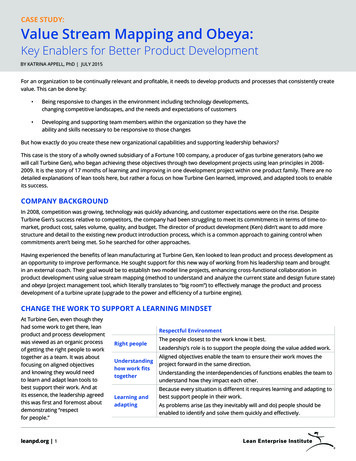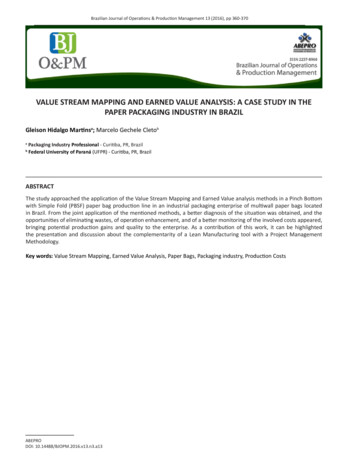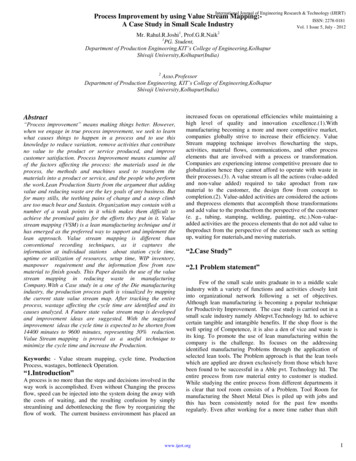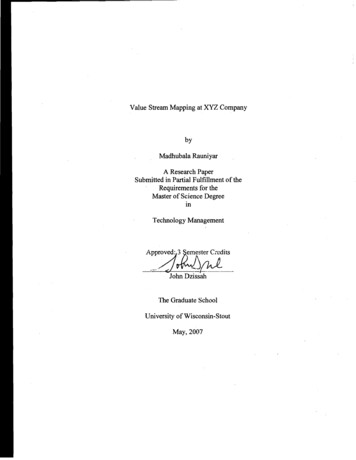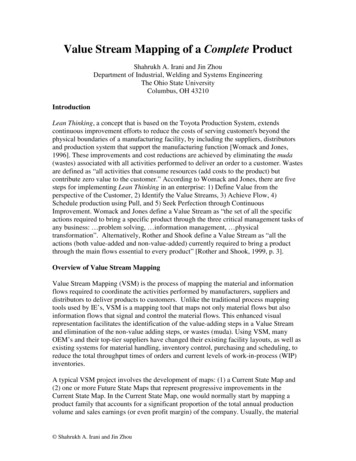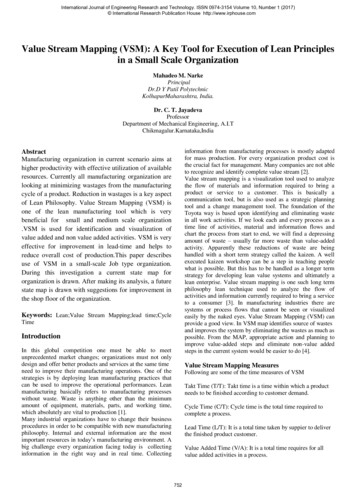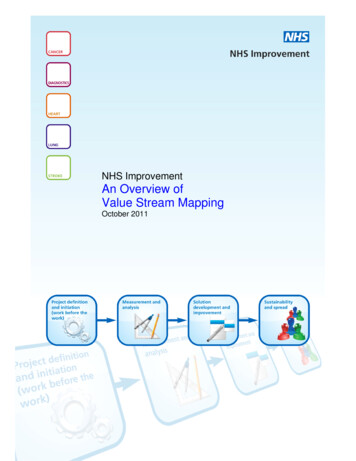
Transcription
NHS ImprovementAn Overview ofValue Stream MappingOctober 2011
Introduction to Value Stream MappingValue stream mapping is a tool commonly used in lean continuous improvementprogrammes to help understand and improve the material and information flow withinorganisations. Value Stream Mapping borne out of lean ideology captures andpresents the whole process from end to end in a method that is easy to understandby those working the process - it captures the current issues and presents a realisticpicture.Through a simple to understand graphical format, future state (a diagram showing animproved and altered process) can be formulated and defined. The methodencourages a team approach and through the capture of performance measurementdata provides a mechanism to constructively critique activity. Participants in theactivity are encouraged to suggest improvements and contribute towards andimplement an action plan.As with any lean management toolset the principle aim of Value Stream Mapping isto improve processes. This is achieved by highlighting areas of waste within aprocess and therefore enable businesses to eliminate these activities. Value StreamMapping also has the benefit of categorising process activity into three main areas value add, Non value add (but necessary) and waste.While Value stream mapping isn’t overtly complicated it does benefit from somepreplanning – it is important that for example a house style is developed usingcommon graphics for use in the diagrams so that everyone participating does so in acommon language. You need to ensure you consider including the following:* Material Flow* Inventory* Buffer stock* Suppliers, Customers* Material Transport* IT System* Information FlowrdNHS Improvement, 3 Floor, St Johns House, East Street, Leicester, LE1 6NBOctober 2011
Step 1 - Select your sponsor and set expectationsAs with any project, it is important that a sponsor or champion is appointed – thisneeds to be someone who can make decisions, arbitrate solutions, and plan theproject. The sponsor will usually select the processes that will be mapped and willusually have a firm grasp of what achievement is being targeted.Step 2 - Select your teamThe make up of the VSM team is crucial and it is imperative that you adopt a teamapproach. You should ensure that each area or stakeholder of the process isrepresented e.g. Sales, Purchasing, Warehouse etcStep 3 -Select process to be mappedValue Stream Mapping is suitable for most businesses and can be used inManufacturing, Logistics, Supply Chain and some Service orientated Organisations.Step 4 - Collect data and produce current state mapOne of the key foundations of VSM is that it utilises and analyses business data - thisincludes process times, inventory or materials information, customer (or demand)requirements. Do not underestimate the time required to capture reliable data –remember that future state maps will be developed using information captured hereso it’s imperative you have a correct understanding of the business.When mapping your current state, use icons/graphics to represent each step – thematerial flow, the information flow, the supplier and customer.As part of the map calculate the total time taken including both waiting andprocessing time.rdNHS Improvement, 3 Floor, St Johns House, East Street, Leicester, LE1 6NBOctober 2011
Step 5 - Critique Current stateGo mad - work with the rule that no idea is a bad idea - use post-it notes or labels toplace ideas and possible solutions over your current state map - encourage everyoneto play a part - analyse the data and encourage your team to make suggestions as tohow the process could be improved - challenge the current thinking. Comments willusually take the form of suggested improvements, risks or fixed elements whichThe big thing is before moving on to the Future state - you and your team must knowthe process inside out (that's why your Value Stream Mapping!) – check, check andrecheck the processStep 6 - Map Future StateTaking both the current state map and the critiques that you have obtained from theprevious stages - compile a future state map - this should incorporate:* Aligning Output and demand at each stage* Adequate review of process criticisms from Step 3 has taken place* Deployment of Key Performance IndicatorsWhen designing the future state pay close attention to ensure that the processconsiders the customer requirements. The Future state map should aim for a steadystate production - ensuring that there is no surplus materials and maximumproductivity. Ensure that the map takes the following into account, Customer,Supplier, Material Flow, Information FlowrdNHS Improvement, 3 Floor, St Johns House, East Street, Leicester, LE1 6NBOctober 2011
Your Future state map will normally fall into either a Push situation where goods areproduced irrespective of demand or a pull situation where goods are producedspecifically to demand patterns.Key Performance Indicators are an important part of the Future State, and if they arenot already in place you should consider what measures are applicable.Remember that mapping the future state does not change the existing process – it ismerely a method of graphically representing changes that could be made.Step 7 - Create Action Plan and deployTaking the Future State map consider an action plan that could be implemented tochange the current process to the future state. This could be done in a number ofways e.g. it could be staged in that elements are introduced sequentially (this workswell if there is a series of easy to introduce changes that can leverage immediatebenefits. Another method is a “Big Bang” approach – for example – the productionplant in our scenario could close down on the Friday and all the changes required toimplement the future state are implemented over the weekend and the productionteam start up the new process in it’s entirety on the Monday morning. There arevarious options and you should consider your business to get the best method.Step 8 - Measure benefitsAfter the future state has been deployed after a period of time a review should beundertaken where you check to ensure that the benefits expected have beenobtained – review each change made and analyse benefits – Utilise the KPI’sdeployed at Step 4 to provide insight.rdNHS Improvement, 3 Floor, St Johns House, East Street, Leicester, LE1 6NBOctober 2011
Value stream mapping is a tool commonly used in lean continuous improvement programmes to help understand and improve the material and information flow within organisations. Value Stream Mapping borne out of lean ideology captures and presents the whole process f
